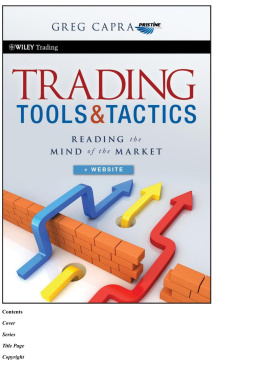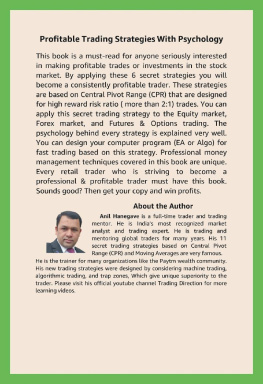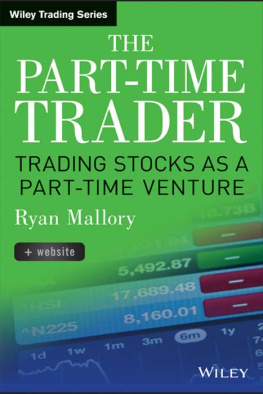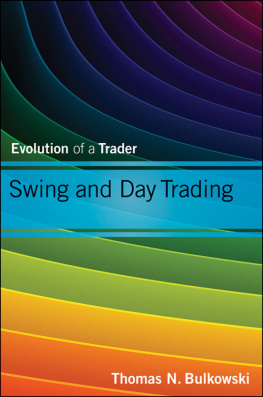ACKNOWLEDGMENTS
I want to acknowledge several people who were largely responsible for my progress and successes over the past 50 years. First, Hank Greenstein was responsible for introducing me to charting and technical analysis. My former brother-in-law, Stephen Feldman, was an early supporter of mine and cocreated our investment club in our late teens; he greatly increased my interest in investments and technical analysis. Joel Bernstein was one of my early mentors and supporters, who encouraged me to have a career in Wall Street. Harris Shapiro, over the past 20 years or so, has greatly assisted and supported me. Harris is responsible for recommending me and introducing me to my current partner in our web site. I remain close friends with him and collaborate daily on investment ideas. I owe Harris a lot for his continual confidence in me to this day. Finally, but certainly not least, I thank my wife, Denise, and daughters, Taylor and Rylee, for putting up with my many days and hours away from them, traveling to speaking engagements and focusing daily on my chart analysis and web site.
ABOUT THE AUTHOR
H arry Boxer has more than 45 years of Wall Street investment and technical analysis experience, including 8 years on Wall Street as chief technical analyst with three brokerage firms. He won the 1995 and 1996 worldwide Internet stock-market trading contest, The Technical Analysis Challenge, sponsored by AmericanInvest.com . Boxer is widely syndicated and a featured guest on many financial programs and sites, including CNBC, CBSMarketWatch, Forbes.com , DecisionPoint, and many more. In addition, he conducts nationwide training seminars on his methods for Worden Brothers. He is currently cofounder and chief writer of The Technical Trader ( www.thetechtrader.com ), a real-time diary of his trading ideas and market analysis, and is also a technical consultant to many Wall Street hedge funds and large institutional traders.
ABOUT THE ONLINE VIDEO
P rofitable Day and Swing Trading is accompanied by two online videos, which expand on the lessons and examples presented in the book:
Day Trading with Harry Boxer
A video of technical analysis techniques for looking at 1-minute and 5-minute intraday trading charts.
Swing Trading with Harry Boxer
A video of technical analysis techniques for short-term and swing trading.
To get the URL and access code for your online video, please refer to the printed card at the end of this book. If you purchased an e-book, you can find instructions for verifying your purchase and obtaining an access code at the end of this book.
Your purchase of Profitable Day and Swing Trading by Harry Boxer includes access to the 80-minute online video seminar. Please go to www.wiley.com/go/boxertradingebook to verify your purchase and receive an access code.
For technical support, please visit www.wiley.com . For telephone support, please contact us at: 1-800-762-2974 (U.S.), 1-317-572-3994 (International).
CHAPTER 1
My Journey as a Trader
W hen I was in my early teens, I became intrigued by the stock market, how and why it moved, and how I could possibly analyze or gauge those movements to benefit financially. I was constantly scouring the newspapers for unusual stock movements using closing prices and wondered how could I use that information in an organized manner for profitable investing.
My big aha moment came a couple of years later when I met a cranky old stockbroker named Hank Greenstein. During the summers in the early 1960s, my parents rented a bungalow in a bungalow colony at Greenwood Lake in upstate New York (quite typical of many Jewish families during that period). Hank was a neighbor in that colony, and I had several conversations with him about the market and investing after I heard he was a stockbroker. One day after Hank and I talked for a while about investing, he said, Young man, you are very bright and inquisitive and tuned in to the market in a way I have never seen in a young man. He then said to me, Come over to my place. I want to show you something related to investing I think youll be very interested in. Hank proceeded to show me something he created by hand called stock charts on graphic chart paper. He literally would add a vertical line or bar to the graph each day showing the high, low, and last closing price. That was certainly a painstaking process, indeed, requiring patience for the patterns to develop over a period of time until they became useful enough to trade on. Keep in mind this was 20 years before the first IBM PC hit the market and the subsequent arrival of charting software!
To say the least, I was very excited! Had I found the Holy Grail for stock investing and trading?? My thoughts ran to how I could use this method for myself, and I asked Hank how I could learn more about this. He suggested I read Technical Analysis of Stock Trends by Robert Edwards and John MaGee (now widely considered the bible of technical analysis).
Based on the charts Hank had created by hand, he recommended three stocks to me in 1962 (shortly after the market had tanked during the Cuban Missile Crisis). Those three stocks were Chrysler (nearly bankrupt earlier), now around $4; U.S. Steel, around $18; and Sperry Rand (maker of the first large mainframe computer UNIVAC), around $13. I decided to invest my summer earnings of $3,000 (a lot at that time) in all three, and the rest is history! Sperry ran to over $40, U.S. Steel over $80, and Chrysler more than 10-fold over $40! Wow, I certainly was hooked for life!!
When I was back in New Jersey at home late that summer I acquired the book and immersed myself in it. I was fascinated and totally engaged. As a matter of fact, I then read it again. Over the years, I have read it six or seven times as a refresherjust to make sure I wasnt getting into bad technical habits or overusing certain technical formations because I was comfortable with them.
After high school, I started an investment club called the Mutual Growth Fund of New Jersey along with my best friend at the time (Gary Fishman), my sisters boyfriend (later husband), Steve Feldman, and his best friend, Neil Prupus, who was a finance major, both in school at Rutgers University in New Jersey. We took approximately $4,000 dollars and later added quite a few more of our friends and associates. Over the next couple of years using primarily technical analysis, we built the clubs assets to nearly $120,000 on an investment of just 30,000!
At that time I also started an investments column in my college newspaper at Fairleigh Dickinson University called The Traders Corner. By doing that column I was able to write down my thoughts and market ideas, which helped me hone my technical analysis and trading skills as well.
During college I often found myself at a brokers office sitting in front of the big electronic tape that scrolled across the top of the room in front where many seasoned (and older) traders congregated. They considered me a young whippersnapper until they saw how well my ideas worked and became curious how I came up with my picks. They were amazed at my knowledge and feel for trading, as well as my fearless approach. An example was a trade I made on then market darling Syntex (the first company to develop a birth control pill). I saw it run from $190 to $250 in just a day after it had run earlier in the week from $150. I decided it was overbought and shorted it near the high and within a couple of days covered it under $200 for a quick 50-point gain!! I quickly became their friend (as you can imagine!) and became part of the traders gang at the office. Thats where I met Joel Bernstein, assistant manager and also a technical analysis advocate. When he saw the depth of my technical skills, he introduced me to the branch manager, Bill Somekh, who asked me if I would be interested in a career as a stockbroker after I graduated from college, which I was thrilled about. However, he wanted me to get some brokerage experience first and suggested I find a position with a smaller Nasdaq firm where I might build my book of clients and then come to work at his office, which I proceeded to do. I found a broker training position at a small firm called Carlton Cambridge in Fort Lee, New Jersey, and worked there for about two years or so before moving to Bill and Joels firm, Weis Voisin & Cannon.

![Harry Boxer [Harry Boxer] Profitable Day and Swing Trading: Using Price / Volume Surges and Pattern Recognition to Catch Big Moves in the Stock Market, + Website](/uploads/posts/book/124137/thumbs/harry-boxer-harry-boxer-profitable-day-and.jpg)




![Ryan Mallory [Ryan Mallory] - The Part-Time Trader: Trading Stock as a Part-Time Venture, + Website](/uploads/posts/book/124134/thumbs/ryan-mallory-ryan-mallory-the-part-time-trader.jpg)





